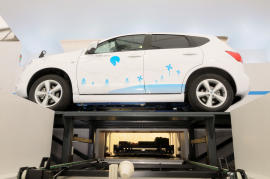 Urban taxi service may be the equal of any proving-ground torture test. Taxis are driven hard, up to 20 hours a day, and must handle both bad roads and bad drivers. Those that survive without falling apart should do fine in civilian duty.
Urban taxi service may be the equal of any proving-ground torture test. Taxis are driven hard, up to 20 hours a day, and must handle both bad roads and bad drivers. Those that survive without falling apart should do fine in civilian duty.
Which is why Better Place chose Tokyo to test out its battery quick-swap technology six months ago–and why it’s now expanding that test to San Francisco as well.
The company has received a grant from the U.S. Department of Transportation to bring its switchable-battery electric taxi program to the San Francisco Bay Area, in partnership with the municipal governments of both San Francisco and San Jose.
As Better Place says in its press release, “Taxis are a high-mileage, high-visibility segment that can serve as the on-ramp for technology transfer to the mass-market.” And their high annual mileage means emissions reductions in taxi fleets have an effect far greater than the number of vehicles might suggest.
The company will build and operate four battery switch stations in the 50-mile-long corridor from San Francisco to San Jose. That route, not coincidentally, passes through the heart of Silicon Valley–as well as Palo Alto, home of not only Stanford University but also Better Place’s U.S. headquarters.
The program involves a breathtaking number of local and regional municipal government and quasi-governmental agencies, advocacy groups, and utilities commissions.
Perhaps more important, it also has both professional taxi operators and car sharing programs as partners, including Yellow Cab Cooperative and Yellow Checker Cab Inc.
San Francisco mayor Gavin Newsom went so far as to call the announcement another step toward making the San Francisco Bay Area “the electric-vehicle capital of America.”
The EV taxi program launched in Tokyo on April 26, with taxis operated by the city’s largest operator, Nihon Kotsu.
Better Place says that in the first 90 days of the test, the fleet of four taxis covered more than 25,000 miles, with the battery switching stations providing extra range when needed. In August, the trial was extended for a further three months.
The electric taxis themselves are modified from the Nissan Dualis compact crossover, similar to the U.S.-market 2010 Nissan Rogue. The 17-kilowatt-hour lithium-ion battery pack is said to provide approximately 56 miles of range.
Switching the packs, Better Place says, takes a mere 60 seconds in its automated switch stations, with passengers remaining in the vehicle. The Tokyo test is meant to find out whether the pack-swapping process can work when used frequently, and what effect it has on the battery packs themselves.
Better Place is continuing to deploy its charging networks and battery-switching infrastructure in the two markets where it will debut, Israel and Denmark. The company says that its commercial launch will come in late 2011.
Written by John Voelcker, this article originally appeared on All Cars Electric, one of VentureBeat’s editorial partners.
Are you a green executive or entrepreneur? If so, sign up now for GreenBeat 2010 — the year’s seminal conference on the smart grid — November 3-4 at Stanford University. World leaders in smart grid initiatives will debate how the new “Super Grid” is creating huge opportunities in cars, energy storage, and renewables. GreenBeat 2010 is hosted by VentureBeat and SSE Labs of Stanford University. Go here for full conference details.
Front page photo via Joe Goldberg on Flickr

